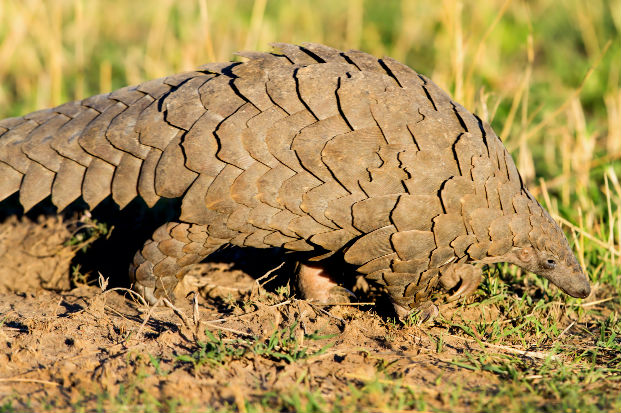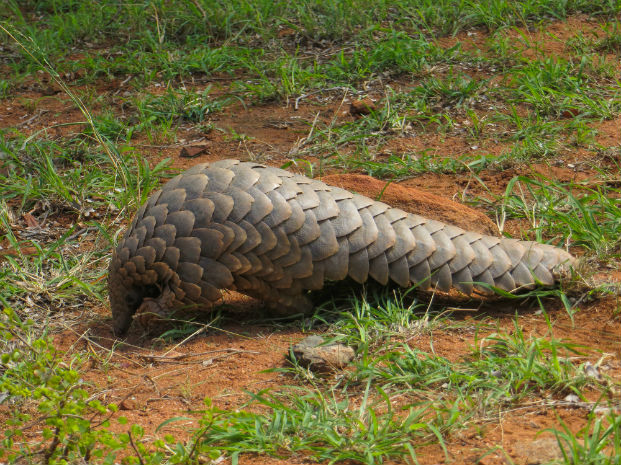Pangolins belong to the order Pholidota. In all there are 8 species around the world, 4 live in Africa and 4 in Asia. Despite all the scales pangolins are not reptiles, they are actually mammals.
These solitary animals are active at night when they hunt for their insect prey which they locate using an acute sense of smell. If threatened they will roll up into a tight ball, sealing itself with its muscular tail.
Pangolins around the world are coming under increased pressure due to poaching for food and use in traditional medicine.
Find out more about the plight of the pangolin as the world’s most poached animal in this Fascinating Africa blog post as well as many more facts.
Facts about the African ground pangolin
1. Tongue length
A pangolins tongue can extend 10 to 15 cm beyond its lips. It starts deep in the chest cavity where it is attached to the lowest part of the breast bone. This means that when it is not in use it can be drawn back in to a cartilaginous structure where it is out of the way.
2. Pangolin diet
90% of a ground pangolin’s diet is made up of ants with the remainder being termites. In one year it may eat 70 million insects.
3. Muscular stomach
A pangolin does not have teeth. Instead its insect prey is ground up in its muscular stomach with the help of sand and soil which it is inadvertently ingested as it feeds.
4. Pangolin parental care
The pangolin has one pup a year. The baby will ride on its mother at the base of her tail.
5. Locomotion
A pangolin will walk on its hind legs using its front legs and tail as a counter balance.
Video length: 2 minutes 23 seconds. Video source: Life on Earth Clips
6. Pangolin scales
A pangolin’s scales make up 20% of its body weight. These scales are made of keratin, the same protein substance which makes up our hair and nails, and of course rhino horn. There is no scientifically proven benefit of keratin as a medicine.
7. Pangolin name origin
The word pangolin originates from the Malay word “pengguling”, which means “something that rolls up”. This is in reference to how the pangolin will roll itself up into a tight ball as a form of defence.
8. Feeding
As a pangolin feeds it laps up insects with its saliva covered tongue. Each time it brings the tongue back into its mouth the insects are scraped off by a bony projection and swallowed.
A must watch pangolin documentary
Eye of the Pangolin is the story of two men on a mission to share the wonder of all four species of African pangolin on camera for the first time ever.
Video length: 45 minutes. Video Source: Pangolin Wildlife Photography
Discover more
Find out more about the plight of the pangolin as the world’s most poached animal in this Fascinating Africa blog post.
Read about safari guide, Jomi Krobb’s, experience of seeing a pangolin for the first time in this post.
Vote for the fact you find most fascinating
The pangolin has one pup a year. The baby will ride on its mother at the base of her tail.
A pangolins tongue can extend 10 to 15 cm beyond its lips. It starts deep in the chest cavity where it is attached to the lowest part of the breast bone. This means that when it is not in use it can be drawn back in to a cartilaginous structure where it is out of the way.
A pangolin’s scales make up 20% of its body weight. These scales are made of keratin, the same protein substance which makes up our hair and nails, and of course rhino horn. There is no scientifically proven benefit of keratin as a medicine.
As a pangolin feeds it laps up insects with its saliva covered tongue. Each time it brings the tongue back into its mouth the insects are scraped off by a bony projection and swallowed.
90% of a ground pangolin’s diet is made up of ants with the remainder being termites. In one year it may eat 70 million insects.
A pangolin will walk on its hind legs using its front legs and tail as a counter balance.
A pangolin does not have teeth. Instead its insect prey is ground up in its muscular stomach with the help of sand and soil which it is inadvertently ingested as it feeds.
The word pangolin originates from the Malay word “pengguling”, which means “something that rolls up”. This is in reference to how the pangolin will roll itself up into a tight ball as a form of defence.




